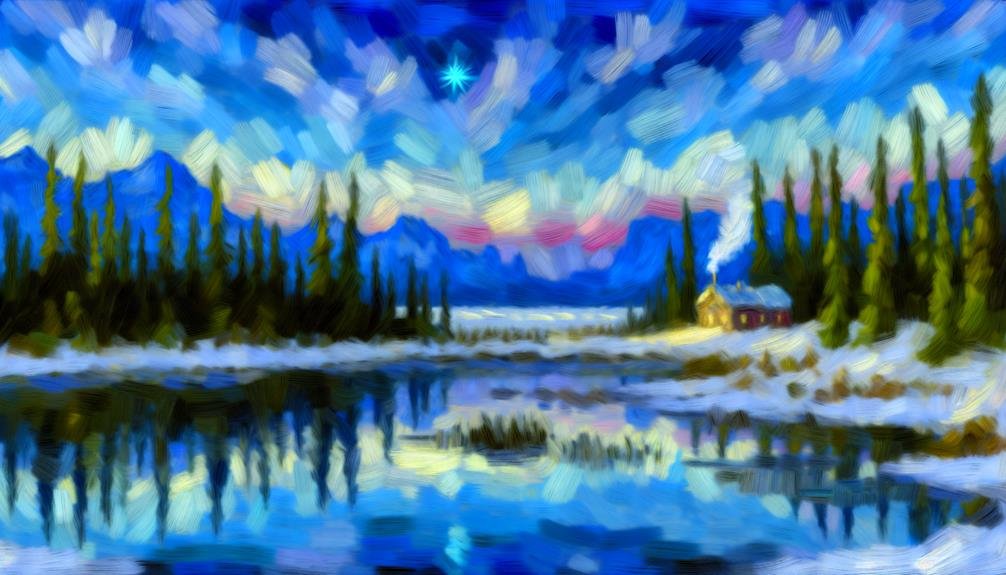Alaska offers unparalleled outdoor recreation opportunities amidst breathtaking natural beauty, showcasing diverse wildlife and endless adventures from hiking to fishing. However, living in Alaska comes with challenges such as harsh winters with frigid temperatures and extended darkness, impacting mental health and creating isolation in remote towns with limited accessibility. High housing costs in cities like Juneau and Fairbanks make renting a practical choice, while the unique phenomena of the midnight sun and polar nights bring both 24-hour daylight and prolonged darkness. This unique blend of pros and cons makes Alaska a truly distinctive place to reside.
Takeaways
- Abundant outdoor activities like hiking and fishing offer unparalleled natural beauty.
- Harsh winters with extreme cold and limited daylight can pose challenges.
- Unique experiences like the midnight sun and polar nights add to the Alaskan lifestyle.
- High cost of living and limited housing options impact residents.
Outdoor Recreation
Alaska offers residents an unparalleled array of outdoor recreational opportunities, ranging from hiking and fishing to skiing and wildlife viewing, set amidst its vast and diverse landscapes.
Denali National Park stands out as a prime location for adventurers seeking to immerse themselves in the state's natural beauty. The park offers summer hiking trails that wind through breathtaking scenery, while winter transforms it into a haven for skiing enthusiasts.
Alaska's abundant waters provide world-class fishing experiences, with anglers flocking to its lakes and rivers in pursuit of prized catches like salmon and halibut.
Wildlife viewing is a common pastime, allowing residents to witness grizzly bears, moose, and orcas in their undisturbed natural habitats.
For water sports enthusiasts, Alaska's over 3 million lakes cater to activities such as boating, canoeing, and kayaking, offering endless possibilities for exploration and adventure in this rugged and enchanting state.
Renting Vs Buying a Home
When considering housing options in the state of Alaska, individuals must carefully weigh the advantages and disadvantages of renting versus buying a home.
Renting in Alaska offers an average one-bedroom rent of $821 and a two-bedroom rent of $922 per month, making it a viable option for those looking to save on housing costs.
The high cost of living in Alaska, particularly in cities like Juneau and Fairbanks, often makes buying a home a significant financial commitment that requires careful budgeting.
Homebuyers should consider getting pre-approved for a mortgage, as this can help streamline the purchasing process in a market with limited housing options.
Many residents face challenges in accessing affordable housing due to a shortage of available properties, making renting a more practical choice for some.
Utilizing a mortgage calculator can help potential buyers assess their options and determine if purchasing a home aligns with their long-term financial goals in Alaska's unique housing market.
Midnight Sun and Polar Nights
The phenomenon of the midnight sun and polar nights in Alaska presents unique challenges and experiences for residents living in the state.
During the summer months, Alaska experiences the midnight sun, offering extended daylight hours for outdoor activities as the sun remains visible 24 hours a day in some regions. Conversely, the winter months bring polar nights to certain areas, where prolonged darkness due to the sun not rising can impact residents' mood and mental health.
The perpetual daylight of the midnight sun can disrupt sleep patterns, posing challenges for maintaining a regular sleep schedule for some Alaska residents. Seasonal Affective Disorder (SAD) is a common issue during the dark winter months, as the lack of sunlight negatively affects overall well-being and mood.
Locations like Barrow (Utqiaġvik) exemplify extreme seasonal variations, enduring 67 consecutive days of darkness in winter and nearly 84 consecutive days of sunlight in summer.
Balancing these contrasting periods of extended daylight and prolonged darkness is essential for the mental health and well-being of Alaska residents.
Beautiful Wildlife
Alaska's breathtaking landscapes are teeming with unique wildlife, showcasing the state's incredible biodiversity.
From grizzly bears hunting for salmon to humpback whales breaching in coastal waters, residents are privileged to witness thrilling wildlife encounters on a regular basis.
The diverse ecosystems and vast wilderness areas provide a habitat for a wide array of species, making Alaska a paradise for nature lovers and outdoor enthusiasts.
Unique Alaskan Wildlife
A myriad of enchanting vertebrate species call Alaska home, showcasing the state's exceptional biodiversity and offering residents unparalleled encounters with majestic wildlife.
Alaska's unique experiences include wildlife observation opportunities like the annual salmon runs, where residents can witness the awe-inspiring sight of grizzly bears feasting on migrating salmon. Additionally, the marine life sightings along the coastal regions provide nature enthusiasts and outdoor adventurers with unforgettable encounters with humpback whales and playful sea otters.
The diverse ecosystems in Alaska support a wide range of majestic creatures, from moose and eagles to orcas, creating a haven for those seeking close connections with nature. Living in Alaska allows for daily interactions with these magnificent animals, making it a dream destination for wildlife enthusiasts seeking one-of-a-kind experiences in the great outdoors.
Wildlife Habitat Diversity
With its abundance of diverse ecosystems and iconic wildlife, Alaska's landscape serves as an enchanting haven for nature enthusiasts seeking encounters with beautiful wildlife. Alaska is home to nearly 1,100 vertebrate species, showcasing its rich biodiversity. The state's diverse habitats, ranging from tundras to forests, provide ideal conditions for a variety of wildlife, including grizzly bears, marine mammals, and salmon runs. Coastal regions like the Inside Passage are teeming with marine life, offering opportunities to spot humpback whales and orcas in their natural habitat. Alaska's wilderness areas enhance wildlife encounters, allowing residents to observe animals like moose and eagles in tranquil settings. The state's unique combination of diverse ecosystems, abundant wildlife, and vast wilderness make it a prime location for those looking to immerse themselves in the beauty of nature.
| Wildlife | Diverse Ecosystems | Habitat |
|---|---|---|
| Grizzly bears | Coastal regions | Alaska |
| Salmon runs | Marine life | Wilderness |
| Marine mammals |
Thrilling Wildlife Encounters
Boasting nearly 1,100 vertebrate species, Alaska offers an enchanting array of thrilling wildlife encounters for residents and visitors alike. The state's diverse ecosystems provide unique opportunities to witness majestic creatures in their natural habitats.
Here are some highlights of the striking wildlife encounters in Alaska:
- Observing grizzly bears, moose, and bald eagles in their natural habitats.
- Prime locations for spotting marine life like orcas and humpback whales, particularly in coastal regions and national parks like Kenai Fjords.
- Witnessing the annual salmon runs that attract grizzly bears, especially at popular spots like Brooks Falls.
- Experiencing Alaska's rich biodiversity, allowing for interactions with wildlife not commonly found elsewhere.
In Alaska, wildlife encounters are not only thrilling but also an integral part of everyday life, adding a unique charm to living in this beautiful state.
Harsh Weather
Alaska's unforgiving winters bring frigid temperatures and treacherous snowfall, creating a challenging environment for residents to navigate. The state is renowned for its harsh winters, with temperatures plummeting below freezing and hitting record lows of -50°F in some regions.
Abundant snowfall blankets the landscape, leading to perilous driving conditions characterized by icy roads and frequent snowstorms. Winter driving in Alaska demands preparedness and caution due to the combination of limited road maintenance in remote areas and the need to navigate through snow-covered terrain, impacting accessibility and safety.
Moreover, the extended periods of darkness during the winter months pose a psychological challenge for residents, with the reduced sunlight exposure contributing to a higher prevalence of Seasonal Affective Disorder (SAD).
Alaska's severe weather conditions, including intense storms and hurricane-force winds along the coast, further underscore the importance of readiness and resilience in the face of nature's forces. Residents must adapt to the extreme conditions to guarantee their well-being and safety during Alaska's harsh winters.
Natural Beauty
Renowned for its breathtaking landscapes and rich biodiversity, Alaska offers a mesmerizing display of natural beauty. The state's stunning natural features include 14 mountain ranges, vast national forests, and an extensive coastline, providing an ideal backdrop for outdoor activities.
Here are some key points highlighting Alaska's natural beauty:
- Rich Biodiversity: Nearly 1,100 vertebrate species and diverse ecosystems attract wildlife enthusiasts.
- Outdoor Activities: Hiking in Denali National Park and kayaking in Kenai Fjords National Park showcase the rugged terrain.
- Untouched Wilderness: Alaska's pristine environments offer awe-inspiring views and opportunities for exploration.
- Northern Lights: Remote areas away from city lights provide vivid displays of this natural phenomenon.
Alaska's natural beauty truly encompasses a dynamic and ever-changing paradise for those seeking to immerse themselves in the wonders of the great outdoors.
Isolated and Remote Towns
The isolated and remote towns in Alaska present unique challenges and opportunities for residents living in these secluded areas. Many of these remote towns are cut off from major road networks, leading to limited accessibility that often necessitates air or water travel, resulting in higher transportation expenses and longer travel times for goods and services. The extended periods of darkness during the long winters can exacerbate feelings of isolation, contributing to mental health challenges among residents.
Despite these difficulties, remote Alaskan communities often thrive on a close-knit social structure, fostering strong local relationships and support networks that help residents navigate the challenges of living in such isolated areas.
The allure of untouched landscapes and abundant wildlife serves as a powerful draw for individuals seeking adventure and a connection to nature, underscoring the unique appeal of living in these remote towns despite the inherent hardships that come with it.
Frequently Asked Questions
What Are the Downsides of Living in Alaska?
When considering the downsides of living in Alaska, factors such as high transportation costs, harsh winter conditions, geographic isolation, potential mental health challenges due to extended darkness, and limited job opportunities beyond specific industries should be taken into account.
What I Wish I Knew Before Moving to Alaska?
Before moving to Alaska, understanding the challenges of extreme weather, isolation, high living costs, and potential mental health impacts due to extended periods of darkness is vital. Preparation, budgeting, and mental health awareness are essential for newcomers.
Is It Worth It to Live in Alaska?
Alaska's unique allure lies in its untamed beauty, diverse wildlife, and financial advantages like the absence of state income tax. However, challenges such as a high cost of living and harsh climate should be carefully considered to determine if residing there is worthwhile.
Can You Live in Alaska Without a Job?
Living in Alaska without a job presents challenges due to the high cost of living and limited job market. Residents can rely on the Alaska Permanent Fund Dividend and engage in subsistence activities, but sustainable living without employment is difficult.
Conclusion
To summarize, living in Alaska offers a unique blend of outdoor recreation opportunities, stunning natural beauty, and diverse wildlife.
However, the harsh weather, isolated and remote towns, and the decision between renting and buying a home present challenges for residents.
Ultimately, individuals considering living in Alaska should carefully weigh these pros and cons to determine if the lifestyle aligns with their preferences and priorities.

